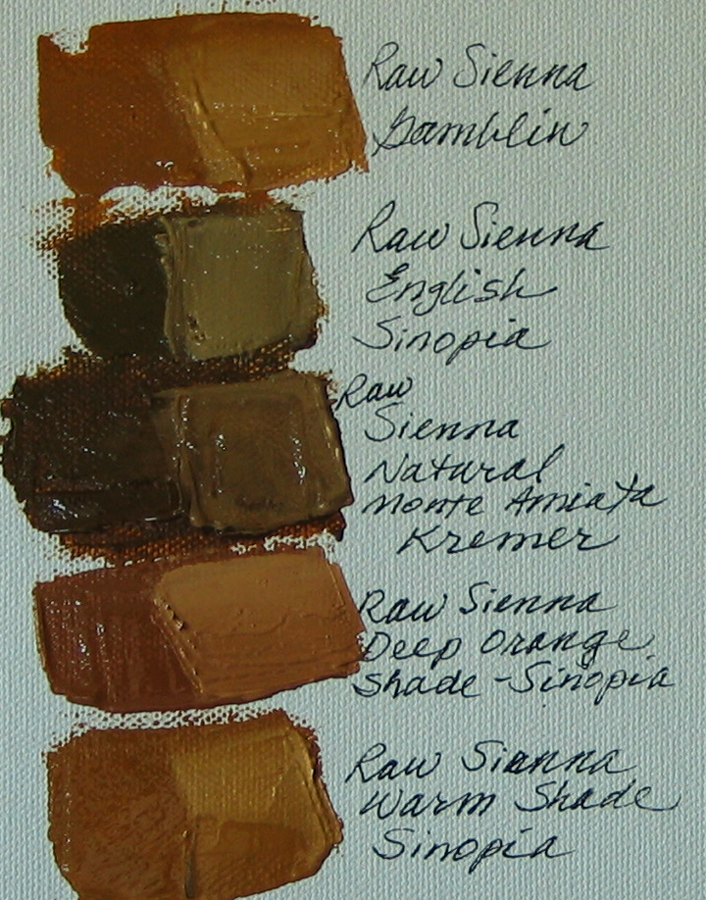A reader wrote last week confused about the differences between the shades of raw sienna and burnt sienna. As you can see by the image here, not only are the shades different from pigment to pigment but also from supplier to supplier. The five samples shown here are the ones I use on my palette. On the left is the pigment in its pure form with linseed added, and on the right with lead white added to bring out the hue more.
The Gamblin sample at the top has a very warm rusty tone while the second one down from Sinopia has a grayed look. The Monte Amiata from Kremer is very dark and chocolaty in appearance. The last two from Sinopia are also very hot in hue but have a subtle difference also. After study of each pigment’s shade quality, it becomes apparent that the differences are because of the geographical origin of each one.


Your painting is simply so beautiful. I so enjoyed reading your information about Burnt Sienna. Working for Grumbacher many years ago
they had a wonderful Sienna but they could not get the pigment any longer with the warm rich hue. Being married to Stan Brown I could go to the warehhouse and get the older tubes which to this day I still have some for personal use.
It is a treat to read your blog and enjoy your talents.
Part one of 3…Susan S you are quite correct. America used to make superb materials. I have a tube of Grumbacher Cad Red Deep given to me in 1959 when I was 14. Painters like Margret honor the alchemy of fine materials. Quickly add to the lost list: mediums by Taubes, rare pigments by Weber, transparent Permasols by Shiva(50’s), and even Binney Smith Liquitex made pure Naples yellow,PY41. Now we have the west coast: Gamblin, Graham, Davinci, Daniel Smith, (and Golden) making paint you can eat right out of the tube. Yes, some good modern colors, but they are the exact opposite philosophy from Margret’s brave reconstruction of the Golden Age. Good..that will make Margret’s work more precious and unique in our corporate art world. Just last week I attended a pigment seminar by Gamblin’s educational rep, Glenn Brill…a terrific guy, but by necessity, a company man. My opinion, Gamblin’s flake white replacement has more in common with pastry icing than flake white.
Part 2…hope I am not too radical in the blog world.
I recently got a post card from Kremer announcing that Dr. Kremer had reacquired the NYC store from Sinopia. It was always my understanding that most of Sinopia’s pigments originated from Kremer and their catalogue numbers seem to support this. So I am hoping that Margret can include in the future the Kremer code numbers. I am especially interested in Raw Siennas called to our attention… there are so many….I am curious about the ‘Monte Amiata’ which Kremer lists as a yellow ochre. I am not trying to correct a detail, but I am interested in that shade of raw sienna as it looks similar to a Maimeri sienna dark that a friend brought back in 68- never found another like it .( again, like Susan’s experience). The color I had was a dark sienna that was very transparent and didn’t go dull with white added. I have never been able to replace it. I have seen a similar effect in the transition zones and shadows of portraits by John Koch. For me at least, all this underscores the subtle but irreplaceable value of so many disappearing pigments. Margret, thanks for sharing!
Part 3…. I forgot what it was